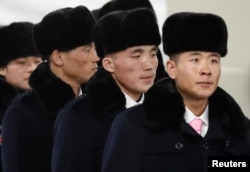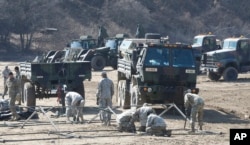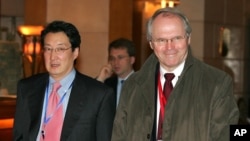A North Korea military parade and talk of a possible U.S. military strike cast an ominous shadow over South Korea’s diplomatic efforts to extend an Olympic truce.
By negotiating North Korea’s participation in the Pyeongchang Winter Olympics Games that begin next week in his country, South Korean President Moon Jae-in seems to have brought about a pause in Pyongyang’s nuclear and missile tests, a delay in joint U.S. and South Korean military exercises, and opened a window of opportunity to search for a peaceful solution to the nuclear standoff on the Korean Peninsula
Military parade
Beyond the Olympics, however, the prospects for peace are daunting. Concessions from North Korea to agree to eventually give up its nuclear weapons, and from the United States to possibly hold off on further joint military drills, would likely be required to expand inter-Korean talks into formal international denuclearization negotiations.
But neither Pyongyang nor Washington has indicated any willingness to compromise.
North Korean leader Kim Jong Un refuses to discuss halting his nation’s nuclear weapons program, which Pyongyang insists is needed to defend against a possible invasion from the United States and its allies in Asia.
To emphasize its defiant stance against international pressure, North Korea is expected to hold a massive military parade Thursday, the day before the Olympics opening ceremony.
Analyzing satellite photos of Pyongyang, 38 North, a North Korea monitoring group, said Wednesday that 12,000 troops and 110 artillery pieces, tanks and armored vehicles have been practicing for a parade. There is also speculation that North Korea will display recently developed intercontinental ballistic missiles that it has been testing in the last year as a demonstration of force.
The South Korean Unification Ministry said any such North Korean military parade would not impact the games.
“The military parade is an event based on North Korea’s internal demand, not suddenly aimed at the Pyeongchang Winter Olympics,” said Baek Tae-hyun, the spokesman for the Ministry of Unification.
The U.S. State Department has objected to the military parade, but Under Secretary of State Steve Goldstein this week also downplayed the likelihood that it would disrupt the Olympics saying, “it is our hope, and I know the hope of South Korea, that the North Koreans ... will join with all the nations of the world in celebrating the athletes.”
Military drills
The administration of U.S. President Donald Trump also indicated it plans to begin joint military exercises soon after the games end. Washington defends the conventional military drills as needed for deterrence and authorized under international law.
In a letter to the United Nations Security Council that was released Thursday North Korea complained about the likely resumption of U.S. led joint military drills, and warned it would not “sit idle” to U.S. efforts to undermine “improving inter-Korean relations.”
Pyongyang also objected to U.S. plans for a preventive limited U.S. military strike reportedly being discussed to give Pyongyang a “bloody nose” in response to a future provocation. Ri Yong Ho, the North Korean Minster for Foreign Affairs said in his letter to the U.N. that such an action would “block the reconciliation process” and drive the region into “an unpredictable dangerous phase.”
U.S. Special Representative for North Korea Policy, Joseph Yun, on Thursday reiterated Washington’s support for dialogue to resolve the nuclear crisis but did not rule out the use force.
“All options are on the table, and by all options, I think you have say, it has to include military options. But again, I would like to caution you that I don’t believe we are close to it,” said Yun, who was in Tokyo this week for consultations with Japanese officials.
Bad options
Concerns that the United States is seriously planning a preventive military strike against North Korea increased this week when Professor Victor Cha, a noted North Korean expert with Georgetown University, reportedly withdrew his nomination for U.S. ambassador to South Korea because of his opposition to the “bloody nose” option.
Writing in the Washington Post, Cha cautioned that such a strike would put at risk the lives of millions in South Korea and Japan in the likely event of a retaliatory strike. North Korea has thousands of missiles and artillery stationed along the border that can target the capital region of Seoul, where half the population of South Korea resides.
Cha’s views are shared by a number of security experts who say that risking a second Korean war would likely decimate the region, and perhaps force China to come to the aid of its ally.
“It is nearly impossible to conclude that preventive use of force is advisable or even the least bad option in terms of advancing our national security interest,” said Kelly Magsamen, a national security analyst with the Center for American Progress, during her testimony before the Senate Armed Services Committee in Washington on Tuesday.
But many North Korea analysts are also highly skeptical that there is currently the trust and political will in Washington and Pyongyang for diplomacy to work either.
“I could not tell you a realistic formula under which North Korea abandons its nuclear weapons programs in the foreseeable future, even with significantly increased pressure,” said Michael Green, a North Korea expert the Center for Strategic and International Studies, during his testimony to Congress this week.
Lee Yoon-jee in Seoul contributed to this report.















